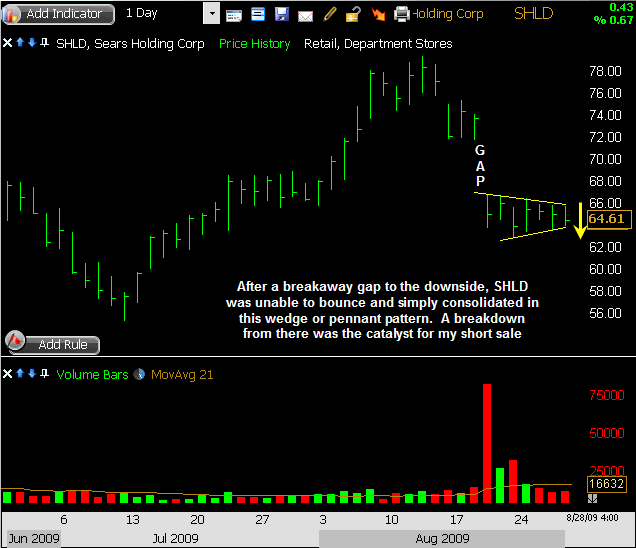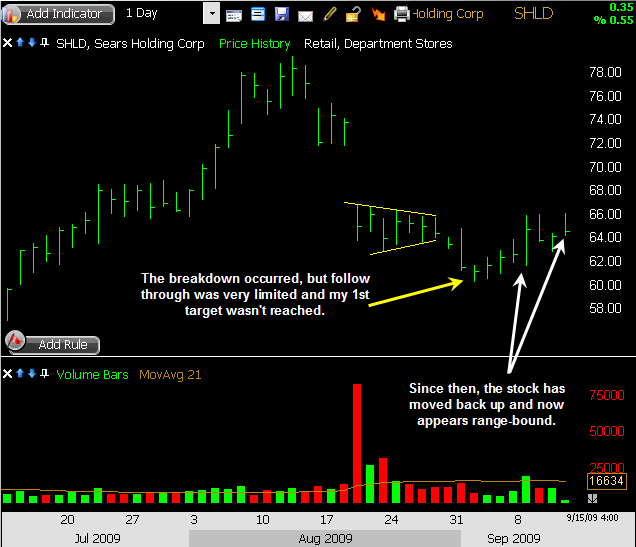Implementing the Time Stop
September 15, 2009 at 10:03 am
Staying patient with a position can sometimes pay off nicely. After all, not every trade works out exactly when we want it to. It might require a little more time than we originally expected before we see that P&L turn the shade of green we were looking for, and it’s sure nice when that happens.
But there is a flip side to the coin.
Sometimes you can be overly patient with a trade, giving it more and more time (dare I say too much?), just waiting for it to make its move. And I’m not referring to letting it move farther and farther against you – you know better than that!
I’m talking about the trade that simply goes nowhere.
Fortunately, there is a solution to the flatlining trade, which is to implement a time-based stop. This is essentially a countdown placed on the trade, that if nothing happens by a certain time, then either an adjustment is made to stop & target levels, or the trade is simply closed out. You know – so you can move on with your life!
After all, why tie up capital in a position which isn’t performing as expected? Kicking a stagnant trade to the curb can translate into more money to be put toward another opportunity, plus it enables us as traders to put our attention toward something more worthwhile.
Show Me the Money!
Just this week I faced this dilemma. I was swing trading SHLD on the short side due to the breakdown from a bear pennant pattern (see chart 1 below), but aside from the initial weakness, there was no follow through (see chart 2 below).
I had designated 2 targets for my exit, and of course 1 stop loss in case the stock reversed and went back above resistance, but none of those levels were reached. The stock refused to go down far enough for me to start booking profits (according to my trading plan), and yet it wasn’t bouncing enough to stop me out either.
Chart 1:
 StockFinder Chart courtesy of Worden
StockFinder Chart courtesy of Worden
Chart 2:
 StockFinder Chart courtesy of Worden
StockFinder Chart courtesy of Worden
Although SHLD was certainly underperforming the market, and I felt confident if market weakness ever arrived that SHLD would crack pretty good, that never happened. The stock simply formed a trading range, and I began to realize it was essentially a stagnant trade.
Time to Move On
Over the weekend, I decided I’d give the stock through Monday before making any moves, and so when it remained in its range, I tightened my stop heading into Tuesday, and today as the stock reached my adjusted stop I closed the position for a minor loss.
I know what some of you are thinking… Why give up on what might eventually develop into a good trade?
Don’t think of this as surrendering or giving up on a trade, because I know that can be difficult for traders who don’t mind being patient. Rather, consider it your responsibility as a trader to keep your capital working for you in the best manner possible.
That means putting it at risk when there’s a good possibility of profiting, and it means protecting it from risk when that potential isn’t present.
The longer we’re in a position as traders, the more we become exposed to company-specific, unplanned news…a surprise, if you will. Leaving a position at risk indefinitely raises the likelihood that news will eventually push the trade one way or the other. The problem with that is that a trade initiated from a technical standpoint should not evolve into a trade which is hopeful for news to make it move. We want real selling or buying to be the deciding factor, and when that turns stagnant then the basis for the trade is negated.
So as you work through your position sheets this week, consider whether some of those stocks are merely resting or if instead they’ve completely lost momentum and are now simply range-bound.
Do your best to determine if a little more patience is needed, or if instead a little less patience is warranted. Time is money, especially for a trader. It might be time to put that trade on the clock and set a deadline. A far better trade just might be waiting for you.
Thanks for stopping by and I’ll see you here soon with more. Until then…
Trade Like a Bandit!
Jeff White
Are you following me on Twitter yet?
Video Review of the Indexes 9-13-2009
September 13, 2009 at 2:58 pm
Although last week was an abbreviated trading week, the bulls wasted no time in getting back to work. In the process, they propelled the indexes to new recovery highs, reaching levels not seen since last fall.
Needless to say, that keeps the uptrend very much intact, but it doesn’t mean reckless buying is warranted here. In fact, in the near term the market has become rather extended, and some rest and/or profit taking could easily develop. And actually, that wouldn’t be such a bad thing…new bases could be established after some rest which would offer a new mix of potential plays.
As we head into a brand new week of trading, let’s examine some important levels in the indexes to keep an eye on in the days ahead. That will have the greatest influence on how individual stocks are going to move, so it’s where the trading week begins.
This clip was also posted over on the Trading Videos site (as always), and perhaps you’ve seen it there – but in case you didn’t, I wanted to put it here on the blog for you.
Let me highly suggest clicking the “HD” on the video player and then going full-screen for best quality.
Thanks for stopping by and I’ll see you here soon with more. Until then…
Trade Like a Bandit!
Jeff White
Are you following me on Twitter yet?
Video Review of the Indexes 9-7-2009
September 7, 2009 at 3:55 pm
Hopefully your Labor Day holiday was a good one! Mine was spent with family, relaxing and celebrating the 2nd birthday of my son – a great way to completely forget about the market in fact!
But it’s time once again to gear up for a brand new week of trading, and I’m excited about it. With Labor Day now behind us, seasonal volume should ratchet up in the weeks ahead, bringing along with it some stronger momentum – regardless of which direction this market moves.
Let’s examine some important levels in the indexes to keep an eye on in the days ahead, as that will have the greatest influence on how individual stocks are going to move.
This clip was also posted over on the Trading Videos site (as always), and perhaps you’ve seen it there – but in case you didn’t, I wanted to put it here on the blog for you.
Let me highly suggest clicking the “HD” on the video player and then going full-screen for best quality.
Thanks for stopping by and I’ll see you here soon with more. Until then…
Trade Like a Bandit!
Jeff White
Are you following me on Twitter yet?
Stack the Odds for Daytrading Success
September 3, 2009 at 5:04 pm
Trading is all about stacking the odds for success. Risks must be taken in order to get paid, but the key is gauging under which circumstances the potential reward really outweighs that risk.
I discussed taking risks in a recent post, and I felt that a follow-up and an example of what I was referring to was in order. Here it is.
Many of my trades are continuation plays. They can be great for offering situations which warrant putting some money on the line once clues of a continued move are present.
However, there are many opportunities on the intraday timeframe which are exhaustion/reversal kinds of setups.
Buy or sell programs, news, and just plain old momentum drive stocks far beyond the pain thresholds of traders, carrying price a considerable distance in one direction or the other. That opens the door for some recoil, and catching the turning point can be quite lucrative.
Stacking The Odds
Here in a moment, I’m going to show you exactly what I mean in a video, but first let me outline a few keys which combined to produce a great trade in this situation.
- Corresponding market action. With the indexes having a distinct possibility of a short-term turnaround, conditions were ripe for similar price action in individual stocks. This is a point I make over and over in the weekly index videos.
- Prior key level on the daily chart of this stock was being tested. A huge intraday move which carries price right to a previously important level on the daily chart will increase the odds for a quick recoil move.
- Intraday price action suggested the move was becoming exhausted. That indicated that a reversal could quickly develop in the stock.
Here’s a video explaining it. Select the HD option and go full-screen for best quality:
Stack multiple factors in your favor for a great trading situation. They’re worth waiting for!
Trade Like a Bandit!
Jeff White
Producer of The Bandit Broadcast
Video Review of the Indexes 8-30-2009
August 30, 2009 at 2:02 pm
The bulls had a wonderful opportunity to thrust the market higher last week, but they passed it up.
Instead, they merely provided support on the dips, preventing any downside damage from being done. It wouldn’t have taken much to push the indexes to new recovery highs once again, but the light-volume action which is so prevalent in late-August conditions prevented any momentum from gaining traction, leaving us in a holding pattern.
This week, we could see that change. The bears could reassert themselves and spark a selloff, thereby giving the bulls something to ponder over the coming 3-day Labor Day weekend. Or, the bulls could simply return to business as usual and keep on doing their thing.
Let’s examine some important levels in the indexes to keep an eye on in the days ahead, as that will have the greatest influence on how individual stocks are going to move.
This clip was also posted over on the Trading Videos site (as always), and perhaps you’ve seen it there – but in case you didn’t, I wanted to put it here on the blog for you.
Let me highly suggest clicking the “HD” on the video player and then going full-screen for best quality.
Thanks for stopping by and I’ll see you here soon with more. Until then…
Trade Like a Bandit!
Jeff White
Are you following me on Twitter yet?
Taking Risks
August 26, 2009 at 1:10 pm
It’s a known fact that in the market, you get paid to take risks. We all know that, right?
But are you getting the proper rewards for those risks? Are you taking the most appropriate kinds of risks? And perhaps most importantly, do you recognize the extent of the damage which can be done when you take on risks which are larger than you can handle?
I’m in the midst of re-reading a great book on risk right now (I’ll put up a post before too long about it, because it’s something you should read), and it’s got my wheels turning. I’m reconsidering exactly what is risk, how much I should be taking, and why I need to embrace it.
Before sharing too much about the book, let me share with you a couple things which are on my mind right now, and I’ll lay out the rest in a later post once I’ve finished the read.
Defined Risks are the Best Kind
Option traders often refer to their ‘max risk’ on a given trade, because on some strategies they are able to truly limit their downside risk to a set amount. If they’re long premium, the most they can lose is 100%, for example.
But an equities trader like me needs to think in terms of a different kind of risk factor. Yes, I could buy 1,000 shares of XYZ at $20 per share, and my max risk (in terms of capital outlay) would be $20,000. But that’s not realistic risk, because it’s so incredibly unlikely that stock is headed to $0 – especially over the course of a few days when I’d expect to be in the trade.
Instead, it’s important when trading stocks to think in terms of max $ risk if the trade fails (not if the underlying company fails). I touched on this concept of dollar risk per trade earlier this month, but let’s look a little closer at it. If I know my entry and I can designate a stop loss on the trade, then barring any drastic circumstances I’ll be able to exit at or very near that stop should an adverse move occur. That’s the risk I want to be familiar with. The kind of risk that says “if this trade doesn’t work out, what do I stand to lose?”
That’s very different from simply looking at every trade from a capital outlay perspective. It’s a major shift for some of you to start thinking this way, but it can also make a major impact on your trading to implement it.
Know Your Exit
Making what could turn out to be a difficult decision before getting in the heat of the moment can be the most important part of your trading plan. It’s one thing to hunt for entry after entry, locating breakout levels and spots where trend lines could get broken, but it’s an entirely different thing to know where you’ll look to exit that same trade, whether it moves in your favor or not.
I’ve said before that a good trade is usually a planned trade, and that definitely involves knowing your exit from the outset of the play. So before you place that order to enter your next trade, decide on where you’ll get out of it. Set a bracket order or jot it down, or at least verbalize it somehow! That’s still better than thinking you’ll get around to it later. Don’t procrastinate – decide on an exit.
Have a Goal
There is no reward without risk, and there should be no risk without reward. Knowing this, there’s absolutely no reason why each trade shouldn’t have some favorable objective associated with it, so set a goal for each trade. A realistic one that could quite feasibly be reached during the course of the trade.
Perhaps you’ll set a hard target and book profits once that level is reached regardless of how strong the momentum seems at the time. Or perhaps you’ll plan to book partial profits at intervals along the way.
At the very least, having some idea of a level where your stock could move to is still going to help you formulate a game plan, even if you don’t choose to leave a resting order in that zone to book profits.
If you know your stop and you have some kind of upside expectation, then you’ll have a far better grasp of just what your risk is on a given trade and whether or not it should be taken.
Thanks for stopping by and I’ll see you here soon with more. Until then…
Trade Like a Bandit!
Jeff White
Reversal Characteristics & Candidates
August 25, 2009 at 12:30 am
Stocks can reverse suddenly or slowly. Sometimes it takes place in one big bar, and other times it’s a process that occurs over time.
Because there are differences in how downside reversals can happen, after running across a couple of reversal candidates in the charts, I wanted to share a couple here on the blog.
Uptrends will often times be followed by corrective action, which may pave the way for further upside down the road. But a reversal is often a longer-lasting change of direction, and that’s what I’d like to discuss in this post.
When looking for reversal candidates, the thing to watch for is a change of character. Something that’s different from previous dips and stands out as a potential shift in the stock. That might be a lower high, or it might be a sudden decline which proves to be much sharper and faster than previous pullbacks were.
Show & Tell
In the video below, I want to point out 2 stocks which might be undergoing reversals. That means there’s plenty more to prove before they can be considered to be in corrective mode (as opposed to merely a dip within their uptrends), but chart reading is always a work in progress. If the characteristics which we’re seeing now happen to change, then so should our expectation.
For now though, let’s take a look at what’s going on and see if these show us the necessary price moves to confirm what the charts of FUQI and RL may already be saying.
Here’s a video explaining it. Select the HD option and go full-screen for best quality:
Thanks for stopping by and I’ll see you here soon with more. Until then…
Trade Like a Bandit!
Jeff White
Are you following me on Twitter yet?





